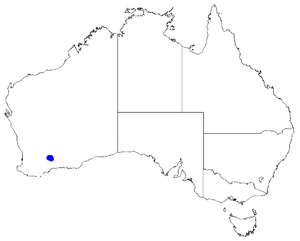Boronia westringioides facts for kids
Quick facts for kids Boronia westringioides |
|
|---|---|
| Conservation status | |
| Scientific classification | |
 |
|
| Occurrence data from Australasian Virtual Herbarium |
Boronia westringioides is a species of erect shrub that is endemic to a small area in the southwest of Western Australia. It has simple, narrow, sessile leaves and pale pink flowers arranged singly in leaf axils.
Description
Boronia westringioides is an erect shrub that typically grows to a height of 75 cm (30 in) and has ascending branches. The leaves are sessile and elliptic, sometimes trifoliate, more or less terete and 5–10 mm (0.20–0.39 in) long. The flowers are borne singly in upper leaf axils on a top-shaped pedicel 1–3 mm (0.039–0.118 in) long. There are leaf-like bracts about 1.5 mm (0.059 in) long at the base of the flowers. The sepals are prominently glandular, triangular to egg-shaped or pointed and 2–3 mm (0.079–0.118 in) long. The petals are pale pink, thin and glandular, elliptical and 5–6 mm (0.20–0.24 in) long. The stamens are gandular near the tip. Flowering occurs from July to October.
Taxonomy and naming
Boronia westringioides was first formally described in 1998 by Paul Wilson and the description was published in the journal Nuytsia from a specimen collected near the road between Hyden and Norseman. The specific epithet (westringioides) refers to the similarity of this species to some in the genus Westringia.
Distribution and habitat
This boronia grows on loamy sandplains in a small area north of Lake King and east of Hyden.
Conservation
Boronia westringioides is classified as "Priority Two" by the Western Australian Government Department of Parks and Wildlife meaning that it is poorly known and from only one or a few locations.


